Arrivals and Departures
Getting to Venice can be as mundane as taking a train or bus to a certain point. However, if you arrive at the airport, start your visit off in Venetian style, and take a water bus, or vaparetto. The water buses run regularly, just pick your destination and your line, and off you go. Tickets are sold in baggage claim, in the airport lobby and right at the dock. Tickets, depending on your route, are about €15 per person and the trip is less than an hour. Private water taxis are also available, but are easily over €100.
We departed Venice by train, from the Santa Lucia station. It is right on the island, and can be easily walked from the Rialto area, as long as you don’t mind hauling your luggage. That brings me to an importation topic- luggage! Unless you’re staying in a hotel right on the canal, you will have to drag your luggage over bridges (with stairs), through tiny alleys and uneven cobblestone streets. Add with the possible flood issue, and you’re better off bringing something small. Do not bring something you cannot carry!
Accommodations
We rented the Palace Ca’Cavalli, near the Campo San Polo. It is excellent- plenty of space, two full bathrooms, a washer/dryer combo, and a full kitchen. It’s bursting with character! It was the best place we stayed in mainland Italy. If you’re traveling in a group or with family, this is a great choice.
Doge’s Palace
Right along with St. Mark’s Basilica and Square, you cannot miss the Doge’s Palace, or the Palazzo Ducale, while in Venice! It was home to the Venetian rulers for centuries. The original palace was built in the 9th century, although none of it remains. Today’s palace was first begun in 1340, with various additions through the 1600s.
Entry is €25, and includes the Doge’s Palace, Museo Corner, Museo Archeologico, Nazionale and Monumental Rooms of the Biblioteca Nazionale Marciana. The Museum Pass is €35 and includes all of these, plus all other civic museums in Venice, Murano and Burano. It may or may not benefit you, depending how many, and which, museums you plan to visit. For example, if you’re only visiting the Doge’s, and say the Burano Lace Museum or the Natural History Museum, you’ll spend more on the pass. Just check before you purchase the all-inclusive pass, especially when there is so much else to see in Venice! Plan to spend at least two hours in the Doge’s Palace alone.
The palace’s museum is fairly small, housed in the original kitchen. It contains some interesting columns and arches, which were at one time exterior décor.
The grand stairs within the plaza are flanked by statues of Mars and Neptune, from the 16th century. The stairs are cordoned off, so you’ll enter via the Golden Staircase, covered in beautiful golden stucco. With an extra ticket, you can enter the Doge’s Apartments, or just continue to the state rooms. The Great Council Chamber is stunning, spend some time sitting in here to observe the artwork on the ceiling. In particular, Tintoretto’s Il Paradiso covers an entire wall. Other artwork, mostly depicting historical events, line the ceiling. Portraits of doges circle the top of the walls.
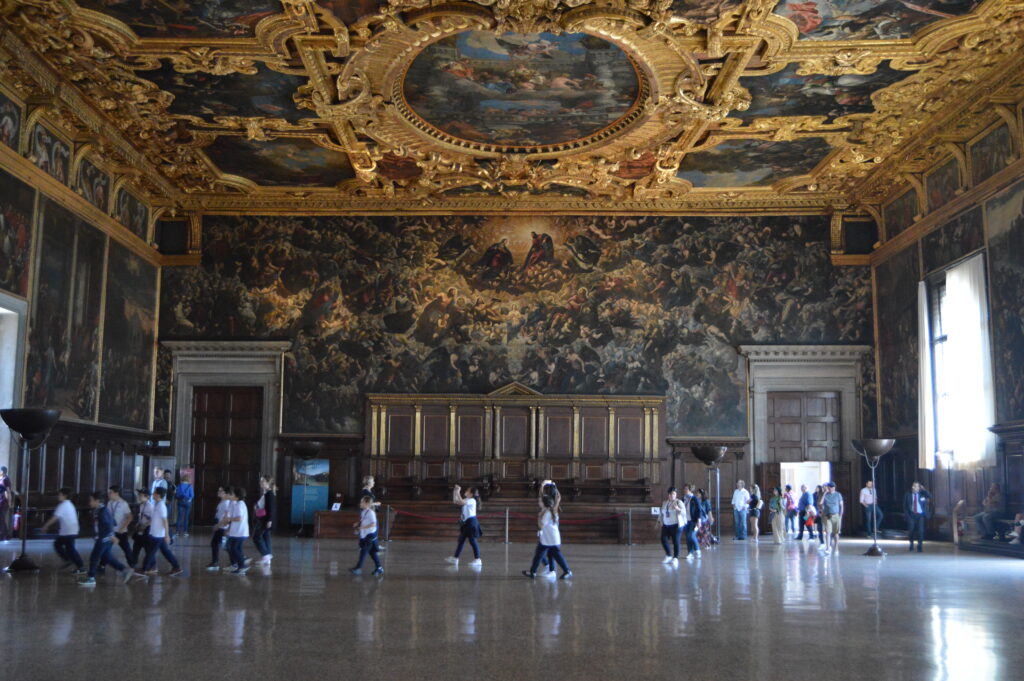
The Great Council and Il Paradiso
Notice the one portrait panel, painted over with a black curtain, and the words “Hic est locus Marini Faletro decapitati pro criminibus” (Here is the place for Marini Faletro, decapitated for his crimes). This doge was executed in 1355, after being accused of treason. Allegedly, he attempted to take sole control of Venice, turning it from republic to monarchy. His portrait was thus covered.
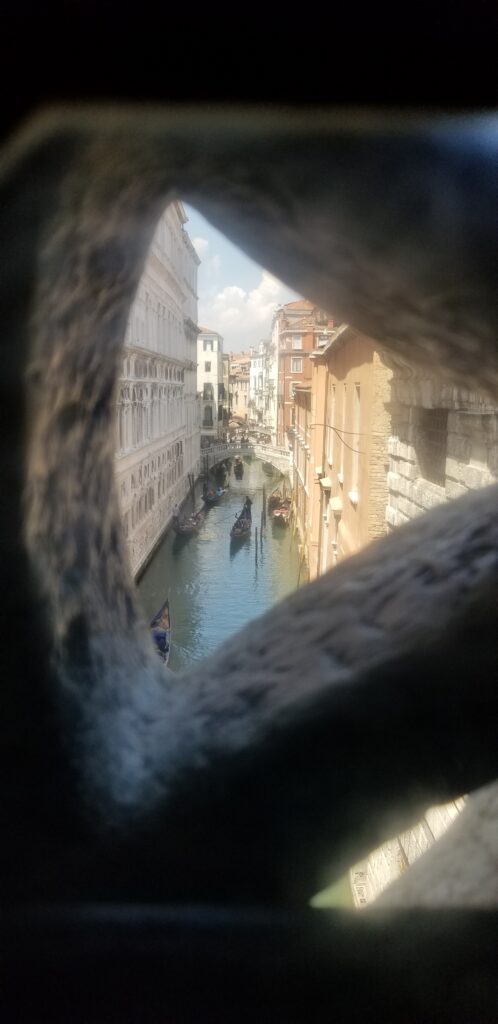
From within the Bridge of Sighs
From the Great Council, exit and cross the Bridge of Sighs into the prison. The Bridge of Sighs is a famous landmark, and earned its name for the prisoners’ sighs as they caught their last view of freedom before entering the prison.
The remainder of your tour will cover the armory, full of swords, crossbows, armor and other deadly objects.
St. Mark’s Basilica is next door, so make time for it as well. I discuss the basilica in my post on cheap and free things to do in Venice.
St. Mark’s Square- Café Florian
After hours walking through the palace and basilica, spend some time enjoying St. Mark’s Plaza. It’s lined with cafes, but the most famous is Café Florian. Founded in 1720, it is the oldest café in the world. A small orchestra plays just outside its entrance, and you can sit outside, or within the opulent interior, complete with gold and mirrored walls and velvet seats. Serving light food, various coffee concoctions and cocktails with a flourish, the waiters are only the best.
Of course, be prepared to pay for the music wafting through the air and your fancy grilled cheese sandwich. My espresso drink was €16, my sandwich €14, and there is a €6 per person charge “for the music”. You’re paying for the experience, but it’s a lovely one.
The original 18th century Cafe Florian room
I recommend a stroll along the waterfront, just behind St. Mark’s Square. You’ll pass the iconic columns of St. Mark and St. Theodore and take a right. Grab a gelato or a bellini, stroll past artists, or just grab a seat along the stone wall. It’s a perfect spot on a sunny day to watch the Grand Canal traffic zip by. The Bar Gelataria Al Todaro has waterfront seating, but at €9 a gelato, I opted for the snack stall a few steps away with €3 gelato and €4 bellinis.
Two ferry terminals and a water taxi stand are within a few minutes of each other here, making it easy to head out to Burano, Murano or Giudecca.
A Day at the Opera(s)
La Fenice
Opera is quintessentially Italian, and Venice has many notable contributors to the art. The La Fenice opera house has a long history, and the audio guide will provide a glimpse into it. Live performances are held regularly, but self guided tours are available daily for €13 (including the audio guide).
La Fenice means The Phoenix, and aptly describes the rise of this theater. It has burned down twice, in 1836 and 1996, since its founding in 1792. It has been lovingly restored each time, to the mantra “Where it was, as it was”, to maintain its original design. Of course, the theater has some modern improvements, including climate control under each seat, and a mobile stage that raises or lowers based on the performance requirements.
When visiting, pay particular attention to the Royal Box, built for Napoleon. From there, you can best observe the theater’s ceiling, which is actually flat, despite its domed appearance.
The last rooms you’ll enter on the tour contain the bar, but are most noteworthy to me for their frescoes depicting scenes from the Divine Comedy. They were painted in 1865 to honor Dante’s 600th birthday!
Musica Palazzo
In case you didn’t get enough opera during your tour, you can of course book a seat at a performance. However, I opted for the Musica Palazzo.
An up close and personal opera performance is given each night in the Palazzo Barbarigo Minotto, a 15th century residence. Scenes are performed in different rooms within the palace, so guests will see multiple areas. Seats are limited to about 40, and there were less than that during my Friday night visit. Performers are often within inches of guests, and in some cases even interact with them.
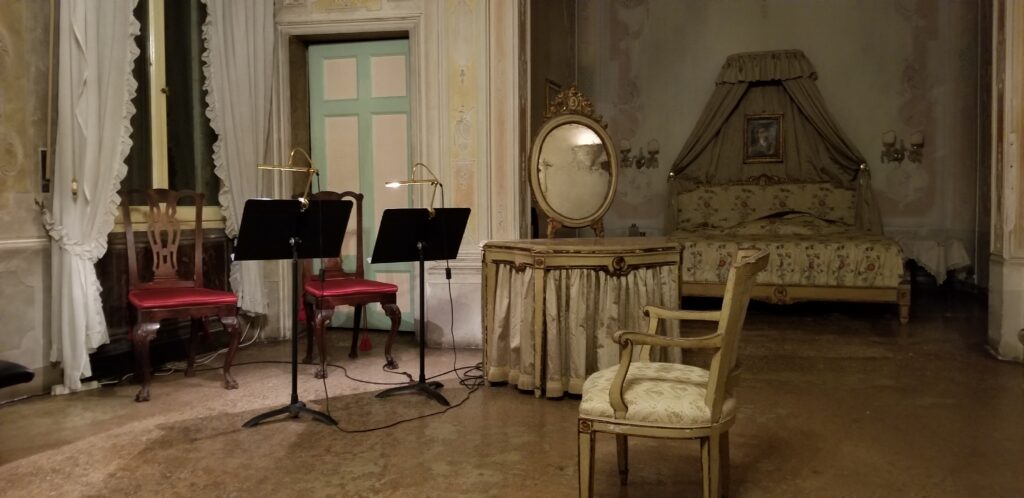
Final room for the last scenes of Rigoletto.
Entry is €85, although technically you are purchasing a membership in the Musica a Palazzo cultural association, not a ticket.
Operas vary by the night of the week. As of 2019, they alternate from Rigoletto, The Barber of Seville and La Traviata.
The entrance is tucked away at the end of a tiny alley, so it’s easy to miss. Google Maps gave incorrect directions, although Apple Maps brought us right to the door.
All About Gondolas
Gondolas seem to get a bad rap, but my experience was great. Before you jump in one, though, confirm your price and route/length of time. The rates are set by the city, and are currently at €80 for 40 minutes, with each additional 20 minute increment for €40. After 7pm, the rate rises to €100. This is not per person, but a flat rate. So, it’s €80 for one person, or if you fill the gondola (6 max).
Personally, I would choose a less frequented gondola stop, rather than some of the larger ones. Yes, there are more gondoliers, but there are also more people. If you don’t have 6 passengers, you could be lumped in the boat with other visitors.
Before I got to Venice, a gondola ride wasn’t even on my must-do list, but I’m so glad we did. It was peaceful, gliding through small canals, and exciting, navigating the crazy traffic on the Grand Canal.
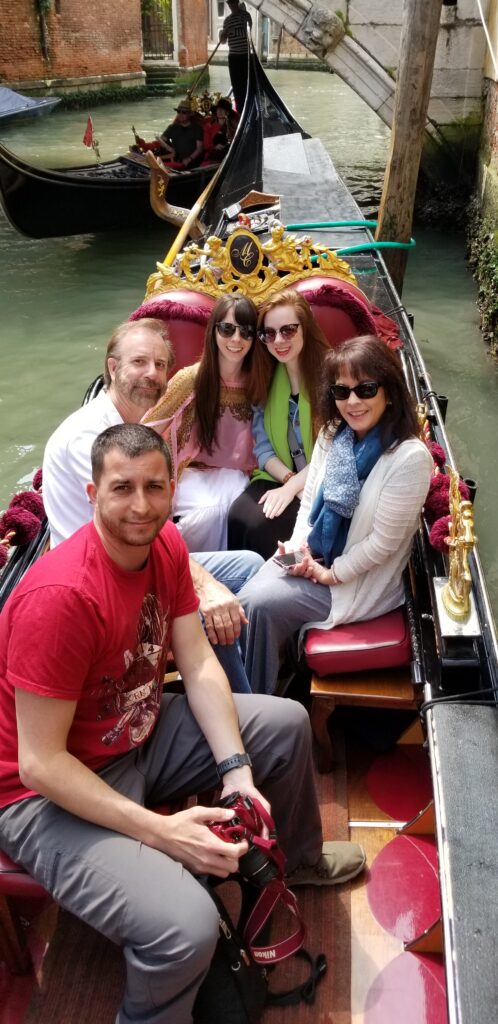
The only photo of all of us!
While we’re on gondolas, I wanted to mention the Squero di San Trovaso. One of the only gondola shops left, it has been making and repairing the boats since the 17th century. Tours are offered to groups of 25 or more, but everyone else can watch the action from across the canal. It’s a short stop, but if you’re in the area, it is interesting to watch the careful work on the gondolas.
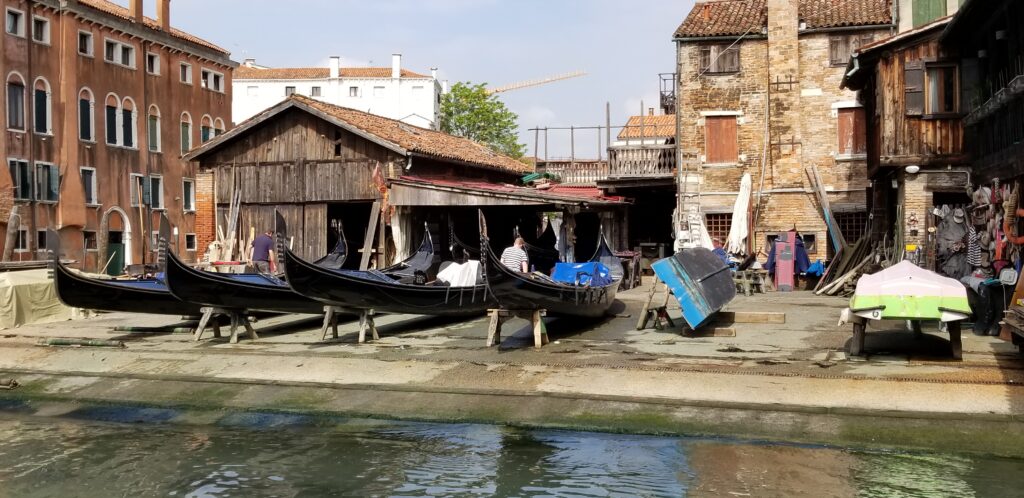
Historic gondola shop
Restaurants
There are hundreds, if not thousands, of restaurants in Venice! Everyone has their own favorites, but I wanted to share two in particular. There are so many restaurants with terrible reviews in the city, you should proceed with some caution. Check reviews and do your homework so you don’t end up with bad food or an exorbitant bill.
It’s safe to assume any sit down restaurant will add a coperto, or cover charge, to the bill. It’s usually around €2 a person, but if restaurants charge it, they are required to list it on the menu.
Al Ponte Storto Osteria con Cucina
San Polo, 1278, Calle del Ponte Storto già Bianca Cappello, 30125 Venezia
Tucked away beside a canal and the Storto Bridge, this small restaurant has indoor and outdoor seating, fresh fish special each day, delicious pasta and good wine at a cheap price. We came twice during our week in Venice, and I can easily say my best meal was here.

Ristorante Antica Sacrestia
Calle de la Corona, 4463, 30122 Venezia
I enjoyed my birthday dinner here, in their beautiful courtyard. The staff are excellent, and we were greeted by the restaurant owner, who explained the menu to us, provided his recommendations and promised us we would have ‘real Italian food, not that American imitation stuff’.
They have a full ala carte menu, or a prix fixe menu with multiple courses. They also brought us spritzes as a welcome drink.
Murano- Day Trip
The islands of Murano and Burano are a short water bus ride away, and make for a great escape from the hustle and bustle of Venice.
My dress matched the colorfulness of Murano!
The Glass
If you are interested in purchasing Murano glass, I definitely recommend a trip to the island. The glass is a decent bit cheaper than on Venice, plus you can visit the Murano Glass Museum and see locals in the glass making process. The glass museum is €14 a person, or is included in the Museum Pass. On Tuesdays and Thursday, they offer guided English tours at 2:30. Also on Tuesdays and Thursdays (at 2pm and 4pm), the Abate Zanetti Glass School provides demonstrations and information on the entire glass making process.
Murano is covered in glass stores and furnaces. We were walking down a side street and came across an open door with a man making glass pigs. He didn’t speak English, but beckoned us inside. The room seemed more like a storage closet, and he wasn’t selling anything. It was interesting to see him work though. I can’t attest if this was true Murano glass, but he was making glass of some sort on Murano.
The Ambiance
I loved the peacefulness of the island, exploring quiet streets without a soul on them. We passed residential apartments, complete with gondolier uniforms hanging out to dry, saw local boys fixing their boat motor, their friendly dog tied to the dock. We sat on a long pier and admired the blue water. There were a few intriguing old buildings, apparently vacant, that conjured stories and mystery in my mind.
Santa Maria e San Donato
Santa Maria e San Donato is a very neat church, with free entry. The stunning mosaic floor dates to 1141, around the same time as the mosaics in St. Mark’s. Interestingly, preservation work in the 1970s cut the floor into sections and lifted it out. The heat, time, and the aqua alta flooding had done damage to the church’s foundation. After repair and the addition of a subfloor, the mosaic sections were carefully relaid as they had been.
More intriguing are the giant bones hanging behind the altar. They are said to be the bones of a dragon slain by St. Donatus of Arezzo. They certainly are large enough to have belonged to some mythical beast!
Santa Maria e San Donato
And of course- the food!
We had a delicious lunch at Trattoria Valmarana (Fondamenta Andrea Navagero 31, 30141 Murano) , which has both canal side seating, and a lovely enclosed courtyard. The food was amazing! The seafood salad was so fresh and delicious, and we ordered both the ravioli on the menu- the best!
Trattoria Valmarana in Murano
I covered much more in my other post on Venice. Happy reading, and future travels!
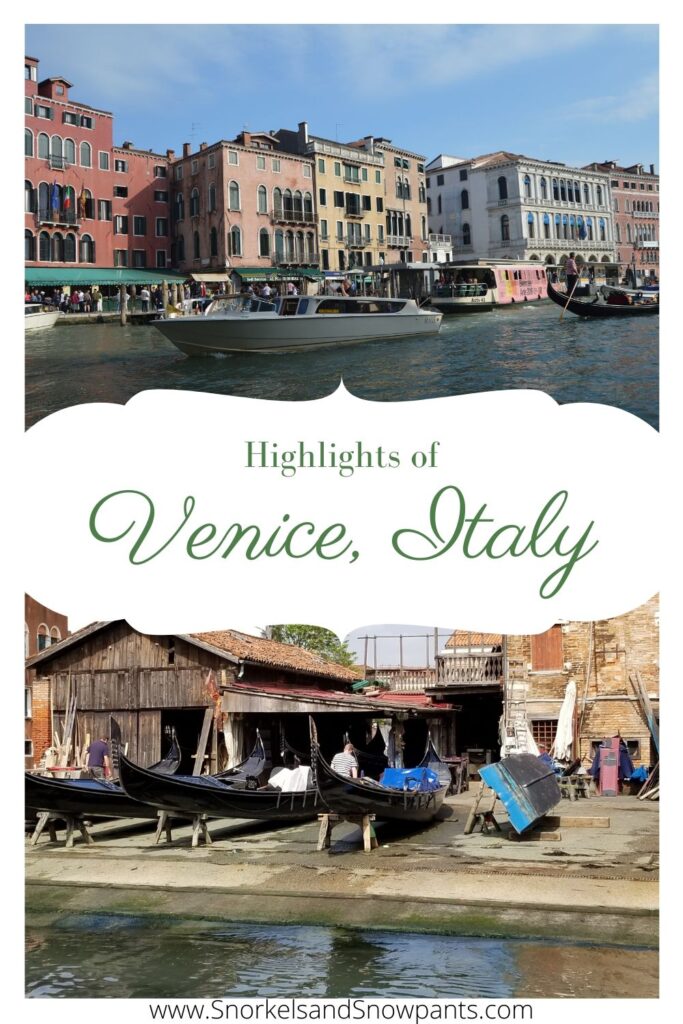

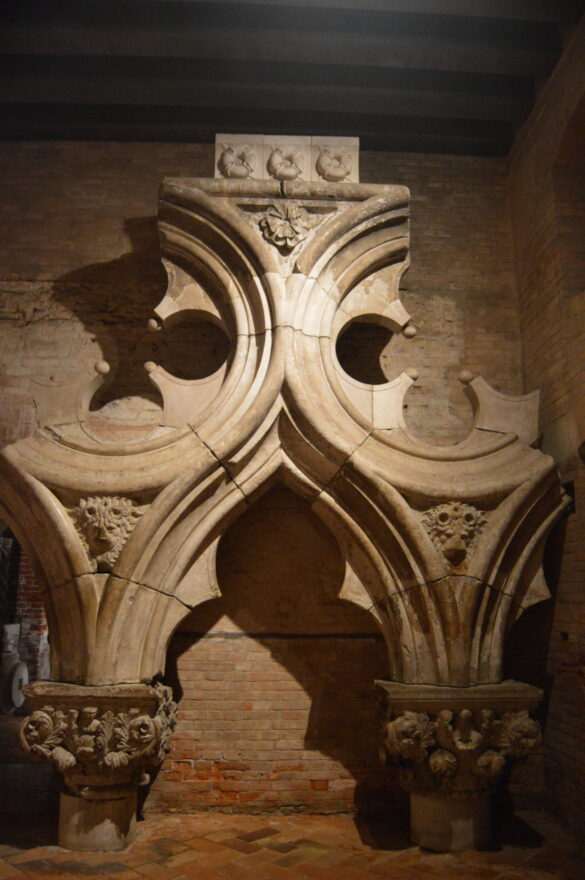
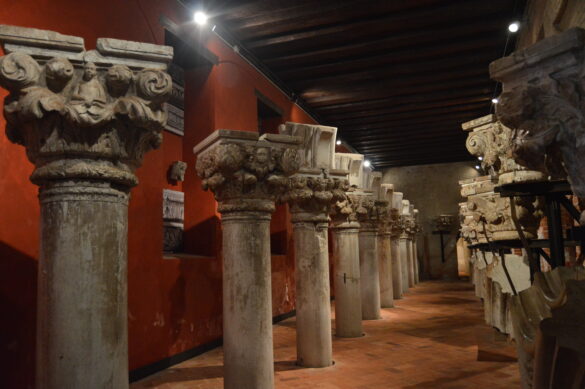
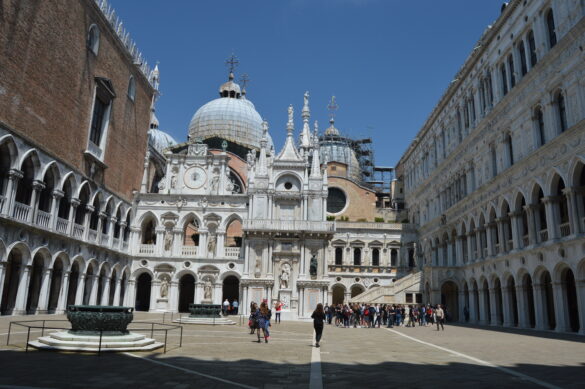

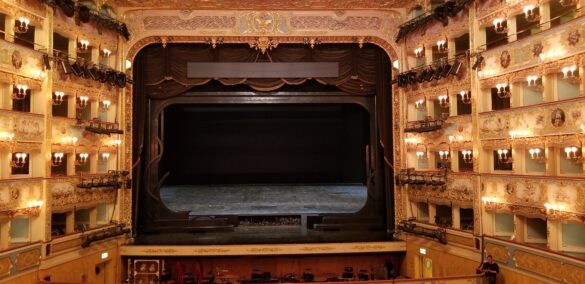
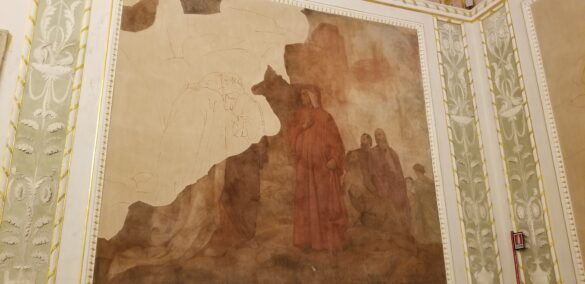
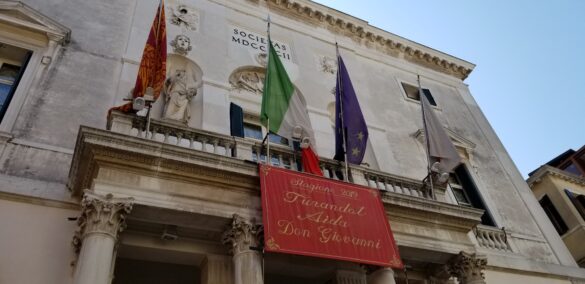
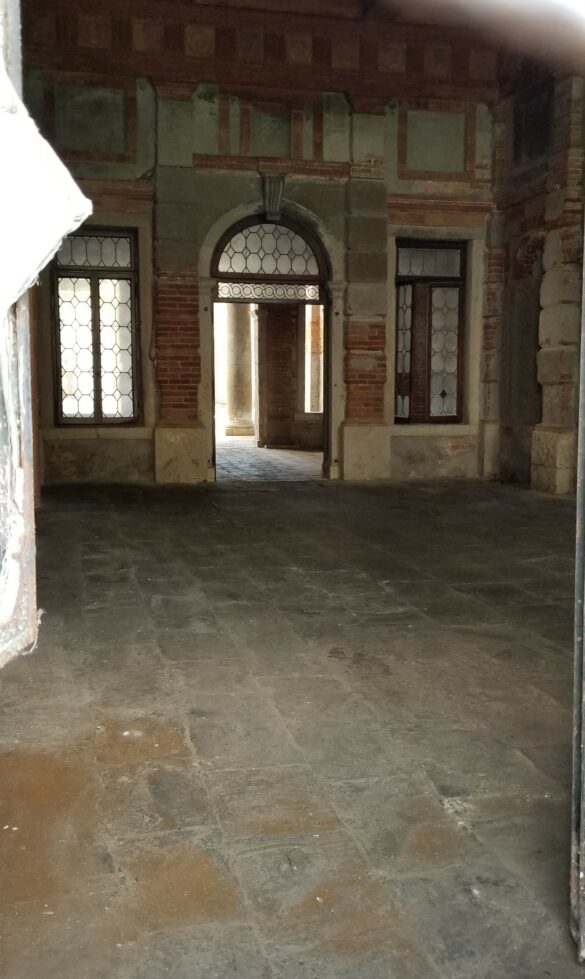
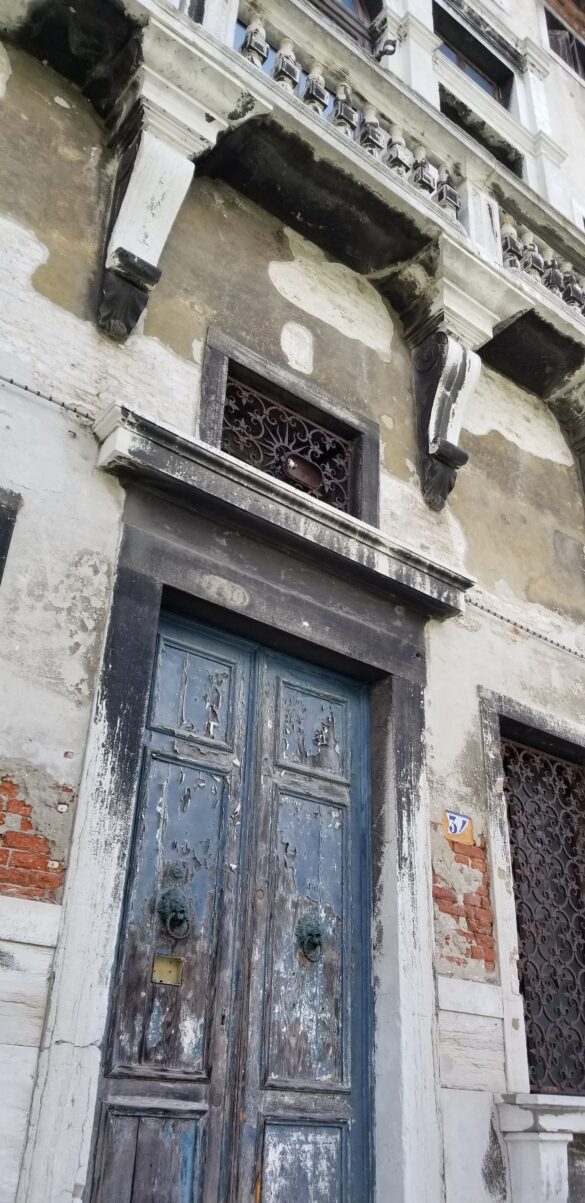
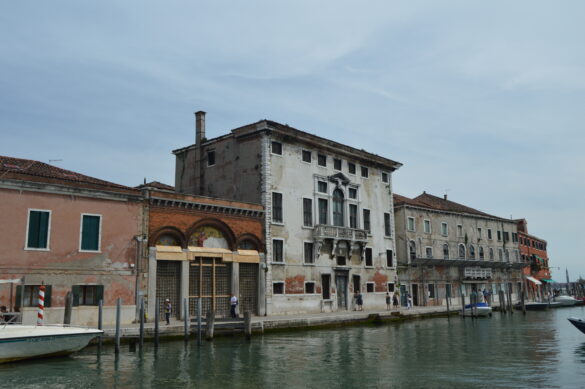
2 comments
Oh Venice! great post- You have me so jonesing to go back. I have only been once, and it definitely left me wanting more. I loved visiting Murano too, and the Gugenheim museum on the canal was another highlight. I’ve seen videos that now with the quarantines, dolphins and swans are returning to swim in the canals. It’s incredible!
I know, the dolphins are hard to believe! Wonder if any sharks have made it!